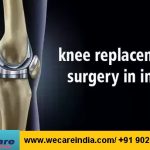AORTIC ANEURYSM REPAIR SURGERY

An aortic aneurysm is a general term for any swelling (dilation or aneurysm) of the aorta, usually representing an underlying weakness in the wall of the aorta at that location. While the stretched vessel may occasionally cause discomfort, a greater concern is the risk of rupture, which causes severe pain; massive internal hemorrhage; and, without prompt treatment, results in a quick death.
Abdominal aortic aneurysms, hereafter referred to as AAAs, are the most common type of aortic aneurysm. One reason for this is that elastin, the principal load-bearing protein present in the wall of the aorta, is reduced in the abdominal aorta as compared to the thoracic aorta (nearer the heart). Another is that the abdominal aorta does not possess vasa vasorum, hindering repair. Most are true aneurysms that involve all three layers (tunica intima, tunica media and tunica adventitia), and are generally asymptomatic before rupture.
Medical treatment for aortic aneurysm in india
Smaller aneurysms (less than 5.5 cm in diameter) that are not at high risk for rupturing are generally treated with medicine used to treat high blood pressure, such as a beta-blocker. Beta-blockers may decrease the rate at which aneurysms grow. In general, the risks of surgery to repair smaller aneurysms outweigh the possible benefits, because smaller aneurysms rarely rupture.
If surgery is not done to repair your aneurysm, you will have regular tests to see if it is getting bigger.
You may need to take medicine to treat high cholesterol and high blood pressure. While these measures have not been proven to slow aneurysm growth, they can improve your life in other ways. These measures reduce your risk of dying from heart attack and stroke, which kills most (66%) people with aneurysms.6 For more information, see the topics High Cholesterol and High Blood Pressure (Hypertension).
Despite some claims, taking antioxidant vitamins has not been proven to reduce the risk of aneurysm or the risk of rupture.
Patients with aortic aneurysms receive the most appropriate treatment in a compassionate environment at we care Health Services vascular centers. Highly trained and experienced specialists work with superb technology to provide exceptional treatment for patients with aortic aneurysms.
Major risk factors for abdominal aortic aneurysms (“AAA”) include age over 60 years, smoking, and high blood pressure. A family history of AAA is particularly concerning so if any of your direct relatives had an aneurysm, tell your doctor so they can arrange a screening exam! The risk of AAA’s increase with age and they are much more common in men than in women. The majority of patients have no symptoms at the time an AAA is discovered. In fact, AAA’s are often detected on tests that were performed for entirely different reasons. Although AAA can be detected by physical examination, most are diagnosed today using ultrasound scan or CAT scans, simple exams that are non-invasive and can be done as an outpatient. These exams can tell us whether an AAA is present and how big it is – the key elements to determine the need for treatment.
Surgical treatment of AAA has been performed routinely for almost 50 years and is one of our most successful and durable operations. In surgery the diseased part of the aorta is replaced with a Dacron or Teflon graft that is carefuly matched to the normal aorta and sewn in place by the surgeon. While ultimately curative, this is an operation that requires a major abdominal incision and general anesthesia, and the hospital stay averages 7-10 days for most patients. Even after uncomplicated surgery, it is often 6-8 weeks before patients can return to a full and normal life. Recent advances in catheter-based technologies have led to groundbreaking treatments for aortic aneurysms.
Symptoms
Aneurysms develop slowly over many years and often have no symptoms. If an aneurysm expands rapidly, tears open (ruptured aneurysm), or blood leaks along the wall of the vessel (aortic dissection), symptoms may develop suddenly.
The symptoms of rupture include : –
- Pain in the abdomen or back : – severe, sudden, persistent, or constant. The pain may radiate to the groin, buttocks, or legs.
- Clammy skin
- Nausea and vomiting
- Rapid heart rate
- Shock
Causes of abdominal aortic aneurysm
The main cause of AAAs is atherosclerosis. This is a condition in which fatty deposits are laid down in the walls of your arteries. The deposit is called an atheroma. This weakens your artery walls and makes them less elastic and weaker as a result.
You are more likely to develop atherosclerosis, and therefore an AAA, depending on : –
- your gender (men are more likely to develop an AAA than women)
- if you smoke
- your age – AAAs are more common people over 65
- your family history – if you have a first degree relative who has had an AAA you have a higher chance of having one yourself
- if you have high blood pressure
- if you do little physical activity
- if you have high cholesterol
- if you are overweight





